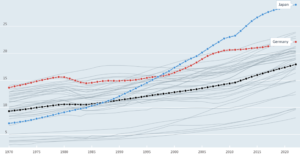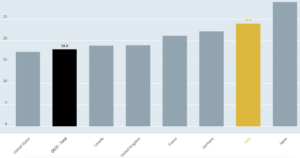The world’s population is aging—and it’s aging pretty fast. In 2018, the number of the world’s population above age 65 already exceeded those below age 5. By 2050, the number of the population older than 65 is expected to double. This so-called ‘graying’ population is an ongoing process happening more rapidly than ever worldwide.
The aging society is especially prominent in developed nations. Japan is at the forefront, with one-third of its population over 65 years old. Germany is another example, where 22.1% of its population is above 65 years old as of 2022 (Figure 1).

There are two main reasons for the rapid increase in the aging population in developed nations: increasing life expectancy and decreasing fertility rate. In advanced states, health care has largely improved. More people are able to easily access health care services and due to technological advancements, there have been more intricate measures to cure symptoms. This has led to higher life expectancy rates.
In contrast, however, fewer women are willing to give birth in developed countries. This is due in part to the increasing proportion of females in the workforce over the past decades and increasingly expensive living expenses. There is less room for the additional cost of raising a child. There are also shifting social perceptions of marriage itself that decrease the fertility rate in traditional family settings. One example is South Korea. While strong Confucianist ideals considered marriage and giving birth as a compulsory act in the past, many individuals nowadays don’t see it as a necessity. A poll from the Korean government that targeted individuals between the ages 19 and 34 highlights only 36.4% of respondents had “positive perceptions of marriage”. Moreover, more than half of the married individuals in the Statistics Korea report didn’t find bearing a child necessary. This accounts for South Korea reaching the world’s lowest fertility rate with just 0.78 this year.
The increasing elderly population and the declining number of younger generations could come as a potential threat to countries because they hamper economic development. With a graying population, states will have to allocate higher proportions of state money to health support for the elderly. This diverts funds on potential investments for new technological innovations. Moreover, the decreasing younger population in the workforce poses a crucial challenge for sustained economic progress. This is especially true in the tech industry. Thus, many countries may not be able to reach their full potential to develop before they start declining.
While there are suggested strategies for decreasing the aging population, some are not long-lasting solutions. For instance, various organizations including the United Nations have considered increasing international migration. The integration of young immigrants would allow for aging to slow down. Yet, there are counterarguments to consider for this solution. While immigration is certainly one of the most short-term viable solutions, it will not provide a long-term solution. Immigrants will also eventually age. Moreover, governments and the population may not be willing to integrate foreigners as residents. Despite Japan having the highest aging society, foreign migration has largely been pushed back. This is mostly relevant for states that have established a sense of unity from a long history and homogeneity of race.
Another solution to consider is increasing the working age. With the advancements in healthcare services, the perception of age has shifted, resulting in people appearing comparatively younger. 60 years old in the past is significantly different from the 60-year-olds in the 21st century. This in turn means that people are able to work for longer years as they are healthier. Therefore, countries could push back the retirement age of workers to ensure that the workforce does not significantly decline due to retired individuals who are able to work for longer. This could also decrease the financial burden of government expenditures spent on pensions for some states. For instance in Italy, the total GDP used for pensions was already 15.9% (Figure 2) in 2019 and those above 65 years old were 23.95% (Figure 3) of the total population in 2022. With the soaring population, there will be a higher financial burden if proper measures are not taken. However, it is also essential to consider the possible drawback of the younger generations having less access to the job market.


Other solutions that have been posed are similarly focused on fostering a healthy environment for the elderly. The United Nations and World Health Organization are currently working on the ‘United Nations Decade of Healthy Ageing’ that lasts until the year 2030 to “improve the lives of older people, their families, and the communities in which they live.” While such measures by the international government are certainly crucial, there needs to be efforts by governments to contextualize the graying crisis and place a greater emphasis on expanding the younger population in the long term.
Edited by Amina Kudrati-Plummer
Shihun Lee is a first year student at McGill University, currently pursuing a B.A. degree in Economics and International Development Studies. She joined Catalyst as a staff writer this year and is particularly interested in international relations and human rights.

